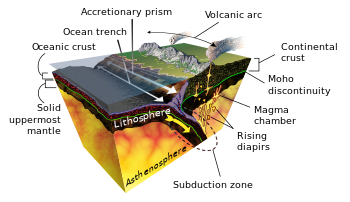Asthenosphere
The asthenosphere (from Greek ἀσθενής asthenḗs 'weak' + "sphere") is the highly viscous, mechanically weak[1] and ductile region of the upper mantle of the Earth. It lies below the lithosphere, at depths between approximately 80 and 200 km (50 and 120 miles) below the surface. The lithosphere–asthenosphere boundary is usually referred to as LAB.[2][3] The asthenosphere is almost solid, although some of its regions could be molten (e.g., below mid-ocean ridges). The lower boundary of the asthenosphere is not well defined. The thickness of the asthenosphere depends mainly on the temperature. However, the rheology of the asthenosphere also depends on the rate of deformation,[4]which suggests that the asthenosphere could be also formed as a result of a high rate of deformation. In some regions the asthenosphere could extend as deep as 700 km (430 mi). It is considered the source region of mid-ocean ridge basalt (MORB).[5]
Characteristics[edit]
The asthenosphere is a part of the upper mantle just below the lithosphere that is involved in plate tectonic movement and isostatic adjustments. The lithosphere-asthenosphere boundary is conventionally taken at the 1300 °C isotherm, above which the mantle behaves in a rigid fashion and below which it behaves in a ductile fashion.[6] Seismic waves pass relatively slowly through the asthenosphere[7] compared to the overlying lithospheric mantle, thus it has been called the low-velocity zone (LVZ), although the two are not exactly the same.[8][9] This decreasing in seismic waves velocity from lithosphere to asthenosphere could be caused by the presence of a very small percentage of melt in the asthenosphere. The lower boundary of the LVZ lies at a depth of 180–220 km,[10] whereas the base of the asthenosphere lies at a depth of about 700 km.[11] This was the observation that originally alerted seismologists to its presence and gave some information about its physical properties, as the speed of seismic waves decreases with decreasing rigidity.
In the old oceanic mantle the transition from the lithosphere to the asthenosphere, the lithosphere-asthenosphere boundary (LAB) is shallow (about 60 km in some regions) with a sharp and large velocity drop (5–10%).[12] At the mid-ocean ridges the LAB rises to within a few kilometers of the ocean floor.
The upper part of the asthenosphere is believed to be the zone upon which the great rigid and brittle lithospheric plates of the Earth's crust move about. Due to the temperature and pressure conditions in the asthenosphere, rock becomes ductile, moving at rates of deformation measured in cm/yr over lineal distances eventually measuring thousands of kilometers. In this way, it flows like a convection current, radiating heat outward from the Earth's interior. Above the asthenosphere, at the same rate of deformation, rock behaves elastically and, being brittle, can break, causing faults. The rigid lithosphere is thought to "float" or move about on the slowly flowing asthenosphere, allowing the movement of tectonic plates.[13][14]
Historical[edit]
Although its presence was suspected as early as 1926, the worldwide occurrence of the asthenosphere was confirmed by analyses of seismic waves from the 9.5 Mw Great Chilean earthquake of May 22, 1960.
Both the lithosphere and asthenosphere are part of Earth and are made of similar material. Lithosphere is made up of Earth's outermost layer, the crust, and the uppermost portion of the mantle. In comparison, the asthenosphere is the upper portion of Earth's mantle (which is also the middle layer of Earth). The lithosphere lies over the asthenosphere. In fact, if any material from the asthenosphere were to solidify, it would become part of the lithosphere.
Being closer to the Earth's core, the asthenosphere is a higher temperature as compared to the lithosphere and hence its rocks are plastic and can flow. In comparison, the lithosphere's rocks are more rigid. The asthenosphere is more dense and viscous in comparison to the lithosphere. The lithosphere is comprised of a large number of fragments, each of which is known as the tectonic plate. These tectonic plates are in constant motion and are floating over the plastic material underneath.
The asthenosphere is a layer (zone) of Earth’s mantle lying beneath the lithosphere.


- It is a layer of solid rock that has so much pressure and heat the rocks can flow like a liquid.
- The rocks are also less dense than the rocks in the lithosphere
- It is believed to be much hotter and more fluid than the lithospher
- Asthenosphere extends from about 100 km (60 miles) to about 700 km (450 miles) below Earth’s surface

The asthenosphere is the ductile part of the earth just below the lithosphere, including the upper mantle. The asthenosphere is about 180 km thick.

Asthenosphere
asthenosphere ăsthēn´əsfēr [key], region in the upper mantle of the earth's interior, characterized by low-density, semiplastic (or partially molten) rock material chemically similar to the overlying lithosphere . The upper part of the asthenosphere is believed to be the zone upon which the great rigid and brittle lithospheric plates of the earth's crust move about (see plate tectonics ). The asthenosphere is generally located between 45–155 miles (72–250 km) beneath the earth's surface, though under the oceans it is usually much nearer the surface and at mid-ocean ridges rises to within a few miles of the ocean floor. Although its presence was suspected as early as 1926, the worldwide occurrence of the plastic zone was confirmed by analyses of earthquake waves from the Chilean earthquake of May 22, 1960. The seismic waves, the speed of which decreases with the softness of the medium, passed relatively slowly though the asthenosphere, thus it was given the name Low Velocity zone, or the Seismic Wave Guide (see seismology ). Deep-zone earthquakes, i.e., those that occur in the asthenosphere or below it, may be caused by crustal plates sinking into the mantle along convergent crustal boundaries. See earth .
